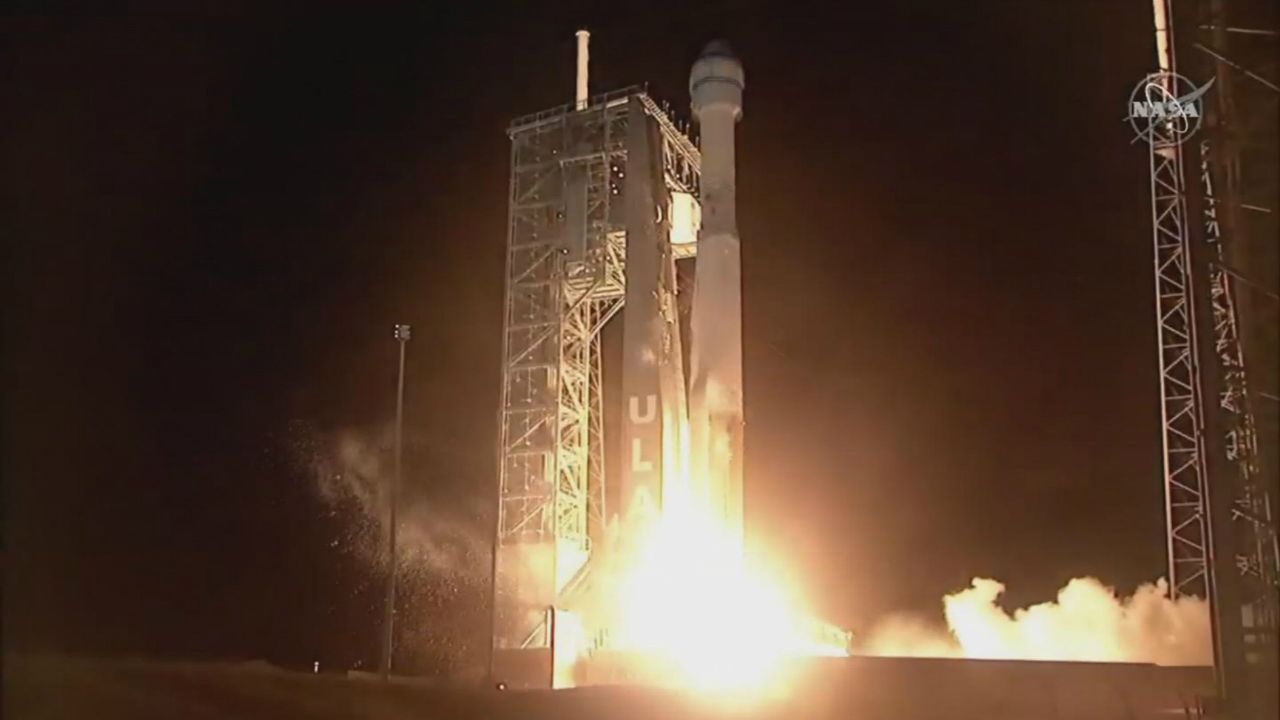CAPE CANAVERAL AIR FORCE STATION, Fla. — A Boeing Starliner capsule blasted off Friday morning on a historic first orbital mission, but NASA officials say an "anomaly" with a critical burn a half-hour after launch will prevent it from reaching the International Space Station as planned.
- Starliner was loaded with supplies, cargo for space station
- Burn necessary for capsule to rendezvous with ISS didn't happen
- NASA hopes to land capsule at White Sands as early as Sunday
- WATCH IT HERE: ▼ Jump to live stream of launch ▼
- RELATED:
An Atlas V rocket from United Launch Alliance lifted off at 6:36 a.m. ET with the CST-100 Starliner on the first of two demonstration flights that will set the stage for NASA astronauts to launch from American soil again.
The @boeing #Starliner launched from #CapeCanaveral Friday on a historic #FirstFlight. This was the view from @dwntwn_orlando as it lifted off.
— Anthony Leone (@AnthonyLeone) December 21, 2019
🚀
Go to @MyNews13 for more.#Space #Florida #Exploration #spaceexploration #Spacecoast pic.twitter.com/irP2ZDetiR
But about 30 minutes after launch, NASA and Boeing officials said the capsule's insertion into an orbit that would allow it to reach the ISS was not normal. NASA Administrator Jim Bridenstine tweeted that the capsule was put in a stable orbit but that the necessary burn to rendezvous "didn't happen."
Bridenstine said during a news conference later Friday morning that the spacecraft was somehow using an incorrect mission-elapsed timer. That led to the spacecraft to go into an orbital insertion burn at the wrong time, and it used up too much fuel.
NASA flight controllers continue to learn from the mission, and Bridenstine insisted on focusing on the positives.
"A lot of things did go right today," he said.
Bridenstine attributed the anomaly in the mission to the automated nature of this first launch. If there were crew on the capsule — as is planned for next year — the astronauts would be safe, and they could have possibly fixed the incorrect timing of the insertion burn and docked with the ISS.
The Starliner is currently in a safe and stable orbit, mission leaders said. Once flight controllers got out of a communications blackout with Starliner during launch, they put the spacecraft in a stable orbit that would allow it to return to Earth as planned. They plan two more burns Friday afternoon to raise its orbit and position it for its return.
The original mission plan was to have Starliner dock at the orbiting outpost just after Saturday morning, December 21. Then it was to head back to Earth, with a planned December 28 landing with parachutes and air bags at White Sands Missile Range in New Mexico.
Officials now hope to bring Starliner back to White Sands as early as Sunday.
The mission — a public-private partnership between NASA, Boeing, and ULA — is a test of the performance of the Atlas V, the Starliner, its in-orbit docking with the space station, and the capsule's return to Earth.
As for another uncrewed flight test, mission managers said it's too early to make that decision.
Although it's an uncrewed flight, the Starliner has a "passenger": "Rosie the Astronaut." Named after World War II icon Rosie the Riveter, the test dummy will collect data to study the flight's effects on a human.
International audience on hand at Cape
"It was an absolutely great show," said Samantha Sykes, who braved windy conditions at Jetty Park at Port Canaveral, a popular location for viewing launches, to witness the launch. "I’ve been to a few of the rocket launches, and I always get really excited when the night ones, right when it fires up. It's like daytime. It lights up the whole horizon, and it’s unreal," the Port Orange resident said.
Jetty Park was packed Friday morning with national and international tourists. Visitors from as far away as Brazil and China turned out to the Brevard County park.
"I loved it. I didn’t think I was going to get to see it, because I just came down here to see them and go to Orlando, but that was pretty great," said Lily Ellis of Evansville, Indiana. "They told me last night that I was going to see it, and I was stoked. It was a nice early Christmas gift."
"It was spectacular. It was something I got to cross off my bucket list," said Ed Lad of Cambridge, Ohio.
Future of astronauts in space
At the Kennedy Space Center on Thursday morning, flanked by the first astronauts who will fly on the Starliner, NASA Administrator Jim Bridenstine spoke of a new era of spaceflight.
"When we start launching into space, it's going to be a great time to be an American, because we will launch American astronauts, on American rockets from American soil," Bridenstine said.
NASA aims to send up that first three-member Starliner crew sometime in 2020. The space agency hopes Boeing and SpaceX can ferry U.S. astronauts to the ISS instead of Russian Soyuz rockets, which it's relied on since the close of the shuttle program in 2011. In 2014, Boeing signed a $4 billion contract with NASA to develop the Starliner.
Boeing astronaut Chris Ferguson commanded the final shuttle mission in 2011. Now, eight years later, he says he's full of optimism about the future of Americans in space.
"We are at the beginning of what I hope will be a long and storied business of transportation service of people to low Earth orbit," Ferguson told Spectrum News.
Ferguson, along with NASA astronauts Mike Finke and Nicole Mann, are the first Starliner crew. They are anxiously awaiting this test flight.
"These are exciting times," Finke said. "This is what we live for. This is how we make spaceflight safe."
In a parallel crew program to the Starliner, SpaceX is also developing a version of its Dragon capsule to carry astronauts.



